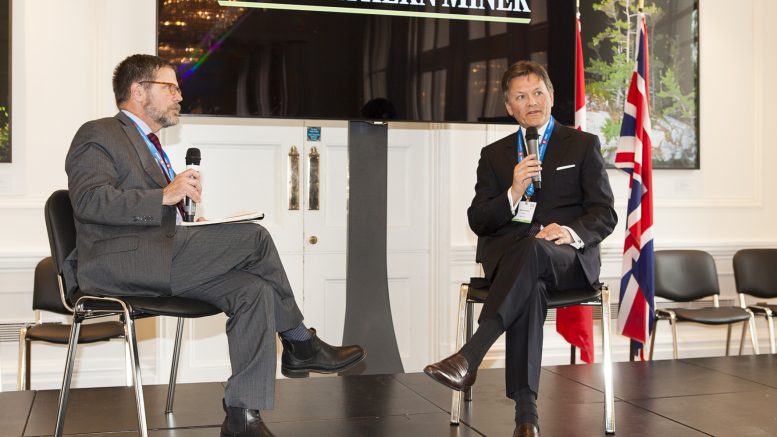At the Canadian Mining Symposium hosted by The Northern Miner at Canada House in London, U.K., in May, session moderator Bill Whitelaw, executive vice-president of Northern Miner parent company Glacier Media, sat down with Kelvin Dushnisky, president of Barrick Gold (TSX: ABX; NYSE: ABX) to discuss the company’s restructuring into a leaner, more focused gold miner, and its new joint ventures at operations around the world. The following is an edited transcript of the conversation.
Bill Whitelaw: Peter Munk formed Barrick Gold in 1983, and within 25 years, it was the world’s biggest gold producer. But growth brings all kinds of challenges in terms of projects that go over budget and top-of-market acquisitions. It’s part of managing those growth pains that Barrick has instituted its Back to the Future strategy, which — like all good companies — looks back on their founding and brings that into the future. Maybe you could reflect on the success of that strategy?
Kelvin Dushnisky: When Barrick started, our iconic founder Peter Munk was a visionary. The first acquisition he made — when Barrick was a small company — was Camflo Mines, and with Camflo came real talent, including Bob Smith — another legend in mining.
The way Peter and Bob structured the business was a clear division of labour: Peter was responsible for financial aspects and strategy, Bob was responsible as an operator for overseeing the mines and making sure the right talent was in place, and making sure the operations ran well — which they did. The model worked very well.
For a long time, Barrick was the only company in the space with an A-rated balance sheet. It had strong financial discipline and projects were built on time and on budget, and that model worked for a long time.
But the reality is that if you go back several years, we lost our way in some sense. Like a lot of companies, we started chasing production — the number of ounces as opposed to quality of ounces. You mentioned an untimely acquisition, when our debt became too high. There were a lot of issues and challenges we had to face.
Intensively, over the last two and a half years, we have been restructuring the business. We have been using the Back to the Future analogy in restoring the discipline to the business.
When we had 27 mines around the world, we used our regional business unit structure.
Over the last while, we’ve been streamlining the portfolio, and we’ve shifted to a decentralized operating model. It’s been very effective.
That means we have a much smaller head office. We removed the layer between the head office and the operating mines and we have empowered the GMs to run the mines — they’re accountable and they have the authority to run the mine as a business — and that’s proven to be an effective approach, and we’re seeing the results.
We’ve reinstituted capital discipline to a higher level than we had four or five years ago.
For the first time last year, we introduced the role of a chief investment officer, whose responsibility is to ensure that our investments meet an internal hurdle rate that we stay strict about.
We have been reshaping the business, trying to put it back to how it looked a number of years ago. Of course times change, and we’ve also been adjusting it for the twenty-first century. We’re introducing a digital platform that generates real-time data to make decisions. We still have a lot of work to do, but we’re pleased with our progress.
BW: As part of recalibrating the company, you’ve gone to the decentralized model, and part of that is showing your leaders of the decentralized model what it’s like on the front lines. So you put your mining managers on the quarterly calls and let them speak directly. How are they finding that, first as individuals, and how are the investors finding that?
KD: You’re right, for probably almost a year now, we’ve had our GMs on the call.
And the reason is part of our commitment to greater transparency. There was a perception that Barrick was a little opaque, and people couldn’t really see into the company. There was a sense that either we didn’t know our way or there was arrogance in terms of not wanting to share information, which was never the case.
We’re giving the GMs the authority and accountability to run the mines, so when someone on the call — an analyst or an investor — has a question about a specific operation, they should hear from the person responsible and who’s running it. So that’s gone very well.
In that same context we’ve paired our GMs in a structure such that we’ve got a GM running the mines and what’s called a country executive director — in the old days you may’ve called it a country manager.
The country executive director’s responsibility is to look after all of the matters outside of the fence, so to speak: licence to operate; corporate social responsibility (CSR), communication, legal and so on. The intent is to let the GMs focus on running the mines. They’re true partners — their compensation is linked — so if one doesn’t do well, the other doesn’t. And that formula has worked well.
BW: When you’re the biggest in the world, you also bear the burden of almost carrying the industry’s load when it comes to things like CSR and social licence to operate. What is Barrick’s philosophy on CSR, and how have we advanced in Canada?
KD: This is something that goes back to the beginning, and it is part of the company’s culture and DNA, which started with Peter Munk and Bob Smith. When Peter brought Camflo into the company, Barrick was, if not the first, certainly one of the first companies to institute a scholarship program. So any child of a Barrick employee anywhere in the world who wanted to attend any post-secondary education — college, university, what have you — is entitled to a scholarship. And that exists today, and there are more than 10,000 kids who have now been educated as a result.
It was a starting point, and things expanded from there to non-governmental organization partnerships and we built — like other companies have — clinics and schools, and so on. But we’ve always viewed the CSR licence to operate as fundamental as production and costs, because if you don’t get that right, it’s difficult to run the operations. We have the benefit of that history.
There’s no question we’ve had missteps along the way. But when we have, we’ve tried our best to correct them quickly, to learn from the mistakes and not repeat them, and move on.
Canada, generally speaking, has a very good reputation. When you travel around the world, one of the calling cards that we always use is the Canadian flag, and that’s one of the reasons. Canadian companies are known for being fair-minded, responsible, honest and transparent. From that perspective, we’re leading the way in many respects in terms of CSR. From Barrick’s perspective, again, individually, we’ve also elevated it.
We have a CSR advisory board that we put in place maybe four years ago, and these are leading figures in the CSR space. None have mining experience, but they’re all seasoned in their respective areas, and they challenge us.
It’s a tough board, in the sense that it’s not just friendly meetings. They really grill management and test our theories and what we’re doing a lot, and that’s helpful.
We also revamped what’s called a Corporate Social Responsibility Committee of the Board, led by one of our independent directors, Nancy Lockhart. It’s a structured committee that holds management to task, and that’s important.
BW: What you think you’re doing in the CSR and social licence space is one thing, but what the communities where you operate think you’re doing is another. Maybe you could speak to Barrick’s engagement at a community level and some of the tangible benefits that the communities achieve as a result of that philosophy.
KD: It starts with consultation and so, at all of our operations, if you go back historically, right back to projects like Alto Chicama in Peru — now called Lagunas Norte — from discovery to production, was just over three years.
Part of that is because there was extensive consultation locally, which helped move the project along. That’s an approach we’ve taken wherever we operate.
Again, it’s one of these things you can never be complacent about because we can always improve — no question about that. But part of the shift we’ve made is increasing access to company information via the Internet, for example. That’s something we find a strong response to, particularly in communities where we’re providing Internet access and WiFi that didn’t exist prior.
The way the world is now — particularly with social media — gone are the days when you could operate in isolation. You can never operate anywhere in isolation, and so it’s best to understand that up front and engage actively, and it’s something we’ve been trying to do.
BW: You mentioned earlier the idea of chasing production and different types of production quality versus non-quality, but Barrick has a philosophy of focusing on cash flow versus production. Why is that important, and what’s important at particular times?
KD: I wouldn’t want to say that we’re not focused on production — we are — but what we’re focused on is quality of production, as opposed to number of ounces.
Like a lot of companies, we got on a treadmill a number of years ago where we forecast a production number — a number of ounces — and to achieve that meant you had to lower the level of discipline that we’ve now put back into the business.
So we’ve very much focused on margin, generating quality ounces over quantity.
The reason we’ve focused on cash flow is because it’s an area that enforces certain discipline. We’ve driven down our costs over the last couple of years.
We still have work to do, but that’s the rationale for it.
BW: You’re a Canadian company, but most of your operations are not in Canada. You’re still headquartered in Toronto, which [has a reputation] as being one of the golden cities for mining headquarters. What’s important about staying in Toronto, and staying Canadian?
KD: Our founder and chairman Peter Munk emigrated from Hungary to Canada, and he really attributes Canada — and Toronto in particular — being a mining centre, as the basis for his success and for Barrick’s success, and I think he’s right.
Toronto and Canada have everything we could look for: the Toronto Stock Exchange and TSX Venture Exchange, all the large engineering companies, the banks, the law firms and the suppliers. There’s a centre of gravity around mining that exists in Toronto that is supportive for the industry.
You add to that supportive provincial governments, territorial governments and associations like the Mining Association of Canada, the provincial associations and the Prospectors & Developers Association of Canada.
There is history and comfort with the mining business that doesn’t exist in a lot of places, and that’s why Barrick will always be in Toronto.
BW: When you think about Barrick’s evolution and growth, you’ve done a lot of JVs and partnerships lately in Chile, Argentina and Saudi Arabia. Why is that a solid, preferred approach to growing a business?
KD: As part of the kind of reshaping of our business we started a few years ago, we also came to the conclusion that we don’t have to do everything ourselves, and particularly if we can enter into a strategic partnership where the partner brings something to the equation as opposed to just money.
It hasn’t been unhelpful that some of the JVs we’ve entered into have helped us deleverage the balance sheet, which is very important. We’ve lowered our debt 40% since 2015, and that was critical, but it’s more than that.
You mentioned a couple of partnerships. One of the first was in 2015, with Zijin Mining from China at our Porgera operation, and that was our first Chinese partnership in terms of running a mine, and that’s gone well for us.
Then we entered into a partnership with Antofagasta Minerals at the Zaldivar mine where we had the view that even though we think we ran Zaldivar quite well, our sense was that Antofagasta could probably run it even better. They know Chile very well, there are synergies, and we’re seeing the results of that.
After that, we entered into a partnership with Ma’aden in Saudi Arabia. Again they bring something different to the table, which was more of a cultural understanding and a better ability to operate in that particular regulatory environment, where we initiated the commercial production at Jabal Sayid in the middle of last year, so that has been going well.
More recently, we announced a partnership with Goldcorp at Cerro Casale. We’re now fifty-fifty in Chile and we look forward to the refreshed thinking they may bring to move that project along.
And then there’s Shandong, which we announced I guess a month ago now. It’s probably a transformational partnership for us, starting at our Veladero mine, where they will acquire 50%, and that transaction will close at the end of June.
There are three phases: one is the partnership in Veladero, where we look forward to generate more value from that asset; the second is to look at Pascua-Lama — and they have an interest in developing Pascua-Lama, provided the economics work out. An advantage of Shandong is that they have strong underground mining experience and the likelihood is that Pascua would be developed as an underground mine, starting in Argentina and moving into Chile. The third aspect of the relationship is to look at the El Indio gold belt, which is a large expanse that we own between Chile and Argentina that hosts Veladero, Pascua-Lama and Alturas — another deposit we’ve announced recently — and so we’re excited about that transaction.
We’re also excited about our partnership in Alaska with NovaGold at Donlin Gold. That’s a rare deposit: 40 million oz., not constrained. It’s going through a permitting process now, and you don’t [often] find deposits like that in a jurisdiction like Alaska.
BW: One theme has been Barrick as a learning organization that helps your staff learn constantly from investment partners and joint venture operations. But when you get to be the biggest, sometimes investors sometimes walk past you looking at other young prospects. If you had one word for the audience here today, why does Barrick deserve a view from investors?
KD: I think of Barrick as kind of the young Barrick of the old days maybe coming back. The fact is we’ve spent the last two years doing a lot of heavy lifting to restructure the company, and put stability back in the business.
We’ve deleveraged the balance sheet and our liquidity position is strong. But importantly, we’ve got a pipeline of greenfield projects, such as Alturas in the Andes — 7 million oz. and growing — and Goldrush in Nevada, at 11 million oz. and growing.
We’ve got a pipeline of organic projects we’re bringing on stream, Cortez Hills in Nevada, Turquoise Expansion, Lagunas Norte, then potentially the restart of Pascua-Lama. And again, projects like Donlin Gold, which are exciting.
From a pipeline perspective, it’s robust. Probably, we’d be the best in the industry.
The decentralized model is operating well. We see the results, and a good testament are the results we saw last year: record cash flow for the company, US$1.5 billion in cash flow and our costs continue to come down. We’re managing that well.
All the ingredients are in place to continue to grow the business. We’re going to stay focused on capital discipline, we’re going to grow margins and we’ve put the company in a position that Barrick is an investment to be considered in any gold price environment.






Be the first to comment on "Barrick’s Dushnisky on miner’s rebound, JVs"